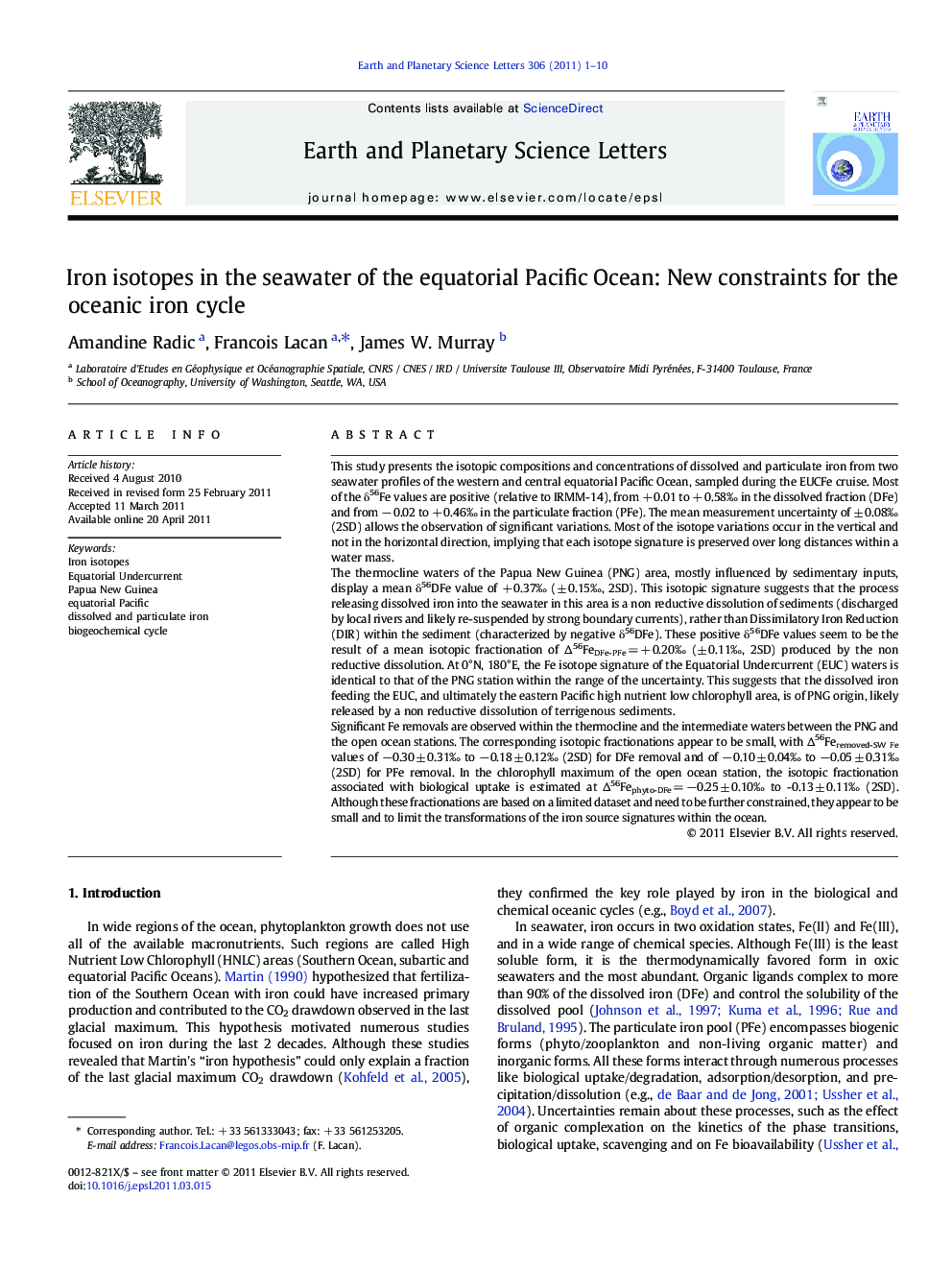| کد مقاله | کد نشریه | سال انتشار | مقاله انگلیسی | نسخه تمام متن |
|---|---|---|---|---|
| 4678058 | 1634828 | 2011 | 10 صفحه PDF | دانلود رایگان |

This study presents the isotopic compositions and concentrations of dissolved and particulate iron from two seawater profiles of the western and central equatorial Pacific Ocean, sampled during the EUCFe cruise. Most of the δ56Fe values are positive (relative to IRMM-14), from + 0.01 to + 0.58‰ in the dissolved fraction (DFe) and from − 0.02 to + 0.46‰ in the particulate fraction (PFe). The mean measurement uncertainty of ± 0.08‰ (2SD) allows the observation of significant variations. Most of the isotope variations occur in the vertical and not in the horizontal direction, implying that each isotope signature is preserved over long distances within a water mass.The thermocline waters of the Papua New Guinea (PNG) area, mostly influenced by sedimentary inputs, display a mean δ56DFe value of + 0.37‰ (± 0.15‰, 2SD). This isotopic signature suggests that the process releasing dissolved iron into the seawater in this area is a non reductive dissolution of sediments (discharged by local rivers and likely re-suspended by strong boundary currents), rather than Dissimilatory Iron Reduction (DIR) within the sediment (characterized by negative δ56DFe). These positive δ56DFe values seem to be the result of a mean isotopic fractionation of Δ56FeDFe-PFe = + 0.20‰ (± 0.11‰, 2SD) produced by the non reductive dissolution. At 0°N, 180°E, the Fe isotope signature of the Equatorial Undercurrent (EUC) waters is identical to that of the PNG station within the range of the uncertainty. This suggests that the dissolved iron feeding the EUC, and ultimately the eastern Pacific high nutrient low chlorophyll area, is of PNG origin, likely released by a non reductive dissolution of terrigenous sediments.Significant Fe removals are observed within the thermocline and the intermediate waters between the PNG and the open ocean stations. The corresponding isotopic fractionations appear to be small, with Δ56Feremoved-SW Fe values of −0.30 ± 0.31‰ to −0.18 ± 0.12‰ (2SD) for DFe removal and of −0.10 ± 0.04‰ to −0.05 ± 0.31‰ (2SD) for PFe removal. In the chlorophyll maximum of the open ocean station, the isotopic fractionation associated with biological uptake is estimated at Δ56Fephyto-DFe = −0.25 ± 0.10‰ to -0.13 ± 0.11‰ (2SD). Although these fractionations are based on a limited dataset and need to be further constrained, they appear to be small and to limit the transformations of the iron source signatures within the ocean.
Research Highlights
► Fe isotopes (δ56Fe) in seawater constitute a new tracer of the oceanic iron cycle.
► We present the first substantial dataset of dissolved and particulate Fe isotopes in seawater.
► The positive δ56Fe values suggest Fe releasing by non reductive dissolution of sediments.
► Water column processes do not seem to fractionate significantly the δ56Fe.
► The signature of each water mass appears to be preserved over long distance.
Journal: Earth and Planetary Science Letters - Volume 306, Issues 1–2, 1 June 2011, Pages 1–10